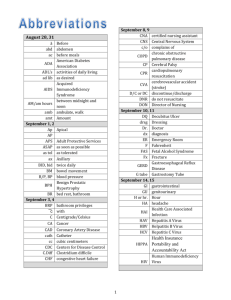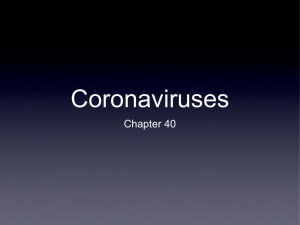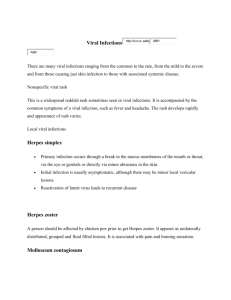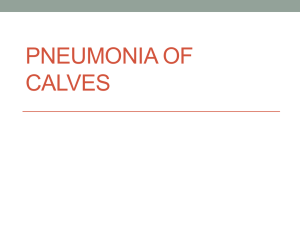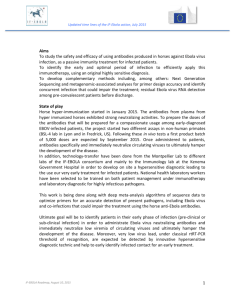Pathology of Infectious Disease II
advertisement
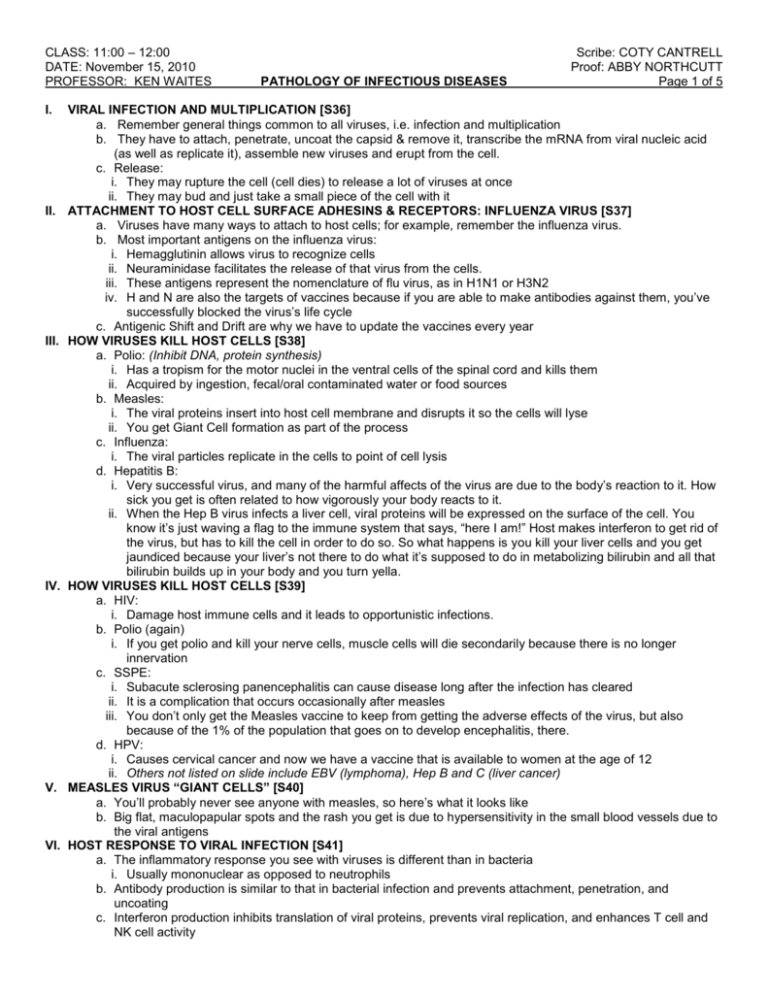
CLASS: 11:00 – 12:00 DATE: November 15, 2010 PROFESSOR: KEN WAITES I. II. III. IV. V. VI. PATHOLOGY OF INFECTIOUS DISEASES Scribe: COTY CANTRELL Proof: ABBY NORTHCUTT Page 1 of 5 VIRAL INFECTION AND MULTIPLICATION [S36] a. Remember general things common to all viruses, i.e. infection and multiplication b. They have to attach, penetrate, uncoat the capsid & remove it, transcribe the mRNA from viral nucleic acid (as well as replicate it), assemble new viruses and erupt from the cell. c. Release: i. They may rupture the cell (cell dies) to release a lot of viruses at once ii. They may bud and just take a small piece of the cell with it ATTACHMENT TO HOST CELL SURFACE ADHESINS & RECEPTORS: INFLUENZA VIRUS [S37] a. Viruses have many ways to attach to host cells; for example, remember the influenza virus. b. Most important antigens on the influenza virus: i. Hemagglutinin allows virus to recognize cells ii. Neuraminidase facilitates the release of that virus from the cells. iii. These antigens represent the nomenclature of flu virus, as in H1N1 or H3N2 iv. H and N are also the targets of vaccines because if you are able to make antibodies against them, you’ve successfully blocked the virus’s life cycle c. Antigenic Shift and Drift are why we have to update the vaccines every year HOW VIRUSES KILL HOST CELLS [S38] a. Polio: (Inhibit DNA, protein synthesis) i. Has a tropism for the motor nuclei in the ventral cells of the spinal cord and kills them ii. Acquired by ingestion, fecal/oral contaminated water or food sources b. Measles: i. The viral proteins insert into host cell membrane and disrupts it so the cells will lyse ii. You get Giant Cell formation as part of the process c. Influenza: i. The viral particles replicate in the cells to point of cell lysis d. Hepatitis B: i. Very successful virus, and many of the harmful affects of the virus are due to the body’s reaction to it. How sick you get is often related to how vigorously your body reacts to it. ii. When the Hep B virus infects a liver cell, viral proteins will be expressed on the surface of the cell. You know it’s just waving a flag to the immune system that says, “here I am!” Host makes interferon to get rid of the virus, but has to kill the cell in order to do so. So what happens is you kill your liver cells and you get jaundiced because your liver’s not there to do what it’s supposed to do in metabolizing bilirubin and all that bilirubin builds up in your body and you turn yella. HOW VIRUSES KILL HOST CELLS [S39] a. HIV: i. Damage host immune cells and it leads to opportunistic infections. b. Polio (again) i. If you get polio and kill your nerve cells, muscle cells will die secondarily because there is no longer innervation c. SSPE: i. Subacute sclerosing panencephalitis can cause disease long after the infection has cleared ii. It is a complication that occurs occasionally after measles iii. You don’t only get the Measles vaccine to keep from getting the adverse effects of the virus, but also because of the 1% of the population that goes on to develop encephalitis, there. d. HPV: i. Causes cervical cancer and now we have a vaccine that is available to women at the age of 12 ii. Others not listed on slide include EBV (lymphoma), Hep B and C (liver cancer) MEASLES VIRUS “GIANT CELLS” [S40] a. You’ll probably never see anyone with measles, so here’s what it looks like b. Big flat, maculopapular spots and the rash you get is due to hypersensitivity in the small blood vessels due to the viral antigens HOST RESPONSE TO VIRAL INFECTION [S41] a. The inflammatory response you see with viruses is different than in bacteria i. Usually mononuclear as opposed to neutrophils b. Antibody production is similar to that in bacterial infection and prevents attachment, penetration, and uncoating c. Interferon production inhibits translation of viral proteins, prevents viral replication, and enhances T cell and NK cell activity CLASS: 11:00 – 12:00 Scribe: COTY CANTRELL DATE: November 15, 2010 Proof: ABBY NORTHCUTT PROFESSOR: KEN WAITES PATHOLOGY OF INFECTIOUS DISEASES Page 2 of 5 i. Interferon is now the cornerstone of treating Hep C to augment body’s own production d. Cellular immunity is also important as in HIV when T-cells are killed and you develop opportunistic infections (usually other viruses and viral-associated tumors such as in Kaposi’s Sarcoma) VII. VIRAL LATENCY [S42] a. Viral latency is something that occurs many, many years later b. For example, in Chickenpox (caused by a herpes virus) will move to the dorsal root ganglia of the spinal cord and remain dormant for many years. Later in life if you get sick from something else, your immune system’s not as good, take a bunch of steroids, or anything else that debilitates your body, the virus can return and produce a disease known as Shingles. i. Will usually present on the distribution of a cranial nerve where the virus is living. So you’ll usually get rash and pain on a specific portion instead of dissemination over entire body ii. Pictured is distribution on trigeminal nerve VIII. PRIONS [S43] a. Not really viruses, but something you should know about. These are neuron proteins that undergo conformational changes. i. Devoid of nucleic acid but are highly infectious & transmissible b. There are sporadic and familial forms, and will result in dementia, ataxia, & death. There is NO treatment or anyway to counteract them. c. Clinically concerned when you have someone with unexplained dementia, followed by motor-sensory dysfunction, characteristic changes in EEG d. Biochemical tests can detect this from spinal tap, but brain biopsies are dangerous because normal infection controls do not kill prions (must use disposable instruments). Regular blood not considered highly infectious, but spinal fluid, brain, and ocular tissue are. e. Examples are mad-cow (bovine spongiform encephalopathy) and Creutzfeldt-Jakob’s disease f. Pictured is what you see in someone’s brain i. Big vacuolizations and encephalopathy, here ii. Big spaces in the brain, there iii. Spongiform encephalopathy, there iv. Concern is if you eat contaminated beef, you can be infected with this disease v. 4-5 cases/year in Alabama IX. FUNGAL DISEASE [S44] a. Here’s my little garden of fungi, here. Aren’t they pretty? Looks like a little flower garden, there. Looks like daisies and sunflowers, there. But actually they’re nasty molds. Now. X. EPIDEMIOLOGY OF FUNGAL DISEASE [S45] a. Some fungi present everywhere (Candida), while some are present in only certain parts of the world (Blastomyces present in Eastern US, but not the Western) b. Most are transmitted by respiratory inhalation (like from the soil) i. Histoplasma not spread from person-person contact c. Cutaneous injection: i. Sporothrix grows on vegetation, and if you stick yourself with a rose thorn, you can get a nasty granuloma d. Opportunistic, systemic i. Candida can be spread when immunocompromised, for example. Common in HIV patients is Oral Thrush. ii. If you see white plaques in the mouth, and you find that the patient has not been taking a lot of antibiotics, you should suspect there’s a defect in the patient’s T-cell immune system and refer them immediately. e. Contact with infected host i. Dermatophytes (Athlete’s foot, ringworm) can spread in community showers, dormitories, etc. XI. FUNGAL DISEASES [S46] a. Some fungi are not dangerous to humans, some are always pathogenic, and some are opportunists b. Blastomyces i. Doesn’t always cause symptoms, but can be contracted in respiratory tract and spread to the rest of the body c. Most fungi infections we see in hospitalized patients are opportunistic such as in HIV or chemotherapy i. Histoplasma is respiratory ii. Candida again can cause this iii. Aspergillus is a BAD organism in the transplant population iv. Cryptococcus used to get a lot of notoriety for causing meningitis in HIV+ patients d. Pictured is Cryptococcus i. Can see the capsulation ii. This can be seen in the spinal fluid with an India Ink test CLASS: 11:00 – 12:00 Scribe: COTY CANTRELL DATE: November 15, 2010 Proof: ABBY NORTHCUTT PROFESSOR: KEN WAITES PATHOLOGY OF INFECTIOUS DISEASES Page 3 of 5 iii. There’s also an antigen test that is used preferentially XII. FUNGAL MORPHOLOGY [S47] a. Fungi can appear as yeasts or molds b. Some fungi like Cryptococcus will always be a yeast, while some like Aspergillus will always be a mold c. Others like Histoplasmosis and Blastomyces (and others) that may be a yeast or a mold depending on the environment, and often has to do with the temperature d. Histo and Blasto, for example, are molds in the environment but are yeasts in the warm environment of the body XIII. MANY DIFFERENT DISEASE MECHANISMS BY ONE GROUP OF FUNGI: ASPERGILLOSIS [S48] a. Fungi can cause disease in many ways, and Aspergillus is used here to describe how even one genus of fungus can cause different types of disease. b. Many different species of Aspergillus c. Will appear in tissues as mold (Pictured revealing septate hyphal forms @ 45˚C) d. Allergic: i. Aspergillus is everywhere, even in this room as a mold. Since it is present in spores, people can develop an allergic hypersensitivity to the them. e. Colonizing disease: typical in people with underlying lung disease (like with TB) i. Usually a cavity that has developed in the lung, and the spores can colonize there f. Invasive: i. Transplant recipient or otherwise debilitated and you inhale Aspergillus, you have no T-cells to combat the spores, you can develop systemic infection g. Exotoxins: i. Fungi, like bacteria, can produce exotoxins; for example, the aflatoxin produced by Aspergillus flavus. Typical in grains, and if you want to kill your cow give it a grain infected with Aspergillus. XIV. HISTOPATHOLOGICAL RESPONSE TO FUNGAL INFECTIONS [S49] a. Just like bacterial histopathological response, fungi can do the same thing b. Candida can produce abscess that looks just like a Streptococcal abscess, and the only way you would know the difference is to do a gram stain c. Histoplasma and Blastomyces can produce granulomas, and the only way you would know the difference is to see the fungus in the culture d. Dermatophytes can cause a cellulitis type of infection e. Blastomyces (IPLAB) causes a mixed pyogenic and granulomatous reaction f. Mucor (IPLAB) and Aspergillus are well known for invading blood vessels. There’s a common ocular complication called rhinocerebral mucor mycosis that is seen almost exclusively in diabetics. Life threatening because by the time they report to your office, the infection is quite extensive. g. Hypersensitivity with no tissue reaction is typical of Aspergillus XV. EUKARYOTIC PARASITES [S50] a. This is Giarda. XVI. HOW EUKARYOTIC PARASITES CAUSE DISEASE IN HUMANS [S51] a. Remember that these are eukaryotic organisms, and they’re more difficult to treat since they are not prokaryotic. b. Some cases they kill host cells by multiplying in them c. Pictured is a patient with HIV i. Cross section of toxoplasma cysts in the brain. You get this from cat feces, which is why immunosuppressed individuals and pregnant women shouldn’t be around this. ii. If you have an HIV patient with headaches and you see lesions in the CT scan, it’s most likely a lymphoma tumor or toxoplasmosis. XVII. HOW EUKARYOTIC PARASITES CAUSE DISEASE IN HUMANS [S52] a. Hookworm. b. Don’t see this very often, acquired via fecal/oral route c. Cause disease by sucking your blood after attaching to mucosa and cause anemia XVIII. HOW EUKARYOTIC PARASITES CAUSE DISEASE IN HUMANS [S53] a. Pork Tapeworm (Taenia solium) b. Causes two types of disease depending on whether you’re the definitive host or the intermediate host c. Normally pig is intermediate host, and obtained in humans by eating pork that contains cysts d. Usually only seen in Mexican immigrants XIX. HOW EUKARYOTIC PARASITES CAUSE DISEASE IN HUMANS [S54] a. Sheep liver fluke (Schistosoma mansoni) b. Induces destructive immune response CLASS: 11:00 – 12:00 Scribe: COTY CANTRELL DATE: November 15, 2010 Proof: ABBY NORTHCUTT PROFESSOR: KEN WAITES PATHOLOGY OF INFECTIOUS DISEASES Page 4 of 5 i. This is a trematode that you get by swimming in water that contain the larvae. Penetrate skin, travel to bloodstream, migrate to lungs where it is then swallowed, travels to liver and deposits eggs. Obstruct bile excretion, cause scarring, and ultimately, cirrhosis. ii. Pictured is egg in liver that has developed granuloma c. As a rule we don’t see this in the U.S. XX. LABORATORY DIAGNOSIS OF INFECTION: DIRECT EXAM OF FLUIDS/TISSUES [S55] a. Decide what type of infection it is likely to be, so you can decide what type of tests you need to run b. Gram Stain i. For example, if you suspect bacterial meningitis you can look at gram stain to see lots of neutrophils with gram negative diplococci inside them, you can have a 99.9% certainty that it’s Neisseria meningitidis and begin treatment XXI. LABORATORY DIAGNOSIS OF INFECTION: DIRECT EXAM OF FLUIDS/TISSUES [S56] a. Acidfast Stain i. For example, if you suspect tuberculosis (because a gram stain wouldn’t reveal this organism) XXII. LABORATORY DIAGNOSIS OF INFECTION: DIRECT EXAM OF FLUIDS/TISSUES [S57] a. KOH prep i. Pictured is the patient with oral thrush. When treated with KOH you can see the yeast under a microscope XXIII. LABORATORY DIAGNOSIS OF INFECTION: DIRECT EXAM OF FLUIDS/TISSUES [S58] a. Stool exam (you don’t culture stool) i. Pictured is intestinal parasite, Ascaris (roundworm) ii. Most times you only see the egg so need to know what that looks like, but sometimes you will see the organism XXIV. LABORATORY DIAGNOSIS OF INFECTION: DIRECT EXAM OF FLUIDS/TISSUES [S59] a. Darkfield exam i. Pictured is a patient with a vulvar lesion, painless shanker. Make a wet prep of lesion, look in microscope in darkfield and you can see motile spirochetes (syphilis). ii. Confirm with antibody tests, but are able to begin treatment XXV. LABORATORY DIAGNOSIS OF INFECTION: DIRECT EXAM OF FLUIDS/TISSUES [S60] a. Histology/Biopsy i. You have a tissue sample, you can use special stains and techniques to identify microorganisms in tissues ii. Pictured is biopsy of tissue PAS stain to reveal carbohydrates in Candida abscess XXVI. LABORATORY DIAGNOSIS OF INFECTION: DIRECT EXAM OF FLUIDS/TISSUES [S61] a. Silver stain i. Useful for fungi and some bacteria like Helicobacter ii. Microorganisms will stain black against green background iii. Especially useful for yeast fungi XXVII. LABORATORY DIAGNOSIS OF INFECTION: CULTURE [S62] a. Good ol’ culture b. Depending on suspicions of ordering clinician, different methods may be used i. i.e. Legionella, anaerobic, mycoplasma, fungal cultures] c. Pictured is Klebsiella and produces characteristic pink mucoid on MacConkey agar XXVIII. LABORATORY DIAGNOSIS OF INFECTION: SEROLOGY [S63] a. Indirect Antigen Detection (ELISA Plate) b. This is a way to indirectly determine if someone has a disease c. Used when organisms that do not grow easily or grow slowly, can still you measurement of antibody for presence of disease d. Used when suspect hepatitis or when making sure vaccine was successful e. Also used when suspect Rocky Mountain Spotted Fever, acute HIV infection XXIX. LABORATORY DIAGNOSIS OF INFECTION: OTHER METHODS [S64] a. Direct Antigen Detection, non-amplified b. Use this to detect Histoplasma, Aspergillus, Legionella, and Cryptococcus (3 fungi and 1 bacteria) c. Reacts an antibody to detect antigen of these organisms XXX. LABORATORY DIAGNOSIS OF INFECTION: OTHER METHODS [S65] a. Skin testing for Delayed Type Hypersensitivity b. First step when looking for TB in an individual XXXI. VIRAL DIAGNOSIS [S66] a. Tissue culture: centrifuged, cultured, and then stained (traditional but increasingly less common) b. Serology: already mentioned c. Histopathology: already mentioned CLASS: 11:00 – 12:00 Scribe: COTY CANTRELL DATE: November 15, 2010 Proof: ABBY NORTHCUTT PROFESSOR: KEN WAITES PATHOLOGY OF INFECTIOUS DISEASES Page 5 of 5 d. PCR: method of choice for detecting viral infections because we can look directly for the associated nucleic acid i. For example in Herpetic CNS, can do PCR of fluid recovered from spinal tap ii. Viral load for Hep C and HIV measured in order to determine efficacy of treatment (not used for diagnosis) XXXII. LABORATORY DIAGNOSIS OF INFECTION: MOLECULAR DETECTION [S67] a. PCR is test of choice for many different things b. Detection of Chlamydia and Gonorrhea in urogenital specimens c. More tests will come along in the future [End 42:27 Mins]

